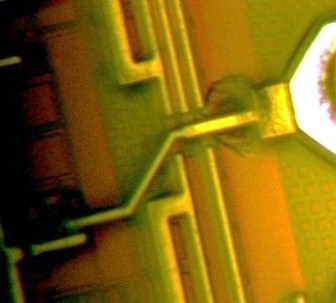Our current APD-TIA ROSA failure is like this:
APD-TIA ROSA mounted in transceiver module with power on, the ROSA was damaged when a burst big input optical power (like 0dBm) into ROSA.
After failure analysis, we found the APD chip breakdown voltage dropped from ~30V to ~14V (breakdown voltage defined at APD dark current equal to 100uA), and TIA Icc is in normal range, but the two output pins (OUT+ and OUT-) common mode voltage difference is big (>0.2V). When inspected under micro-scope, we found obvious damage near the PINA pad of TIA as the following picture showed. We would like to ask:
- Is the following picture showed failure from big current? What's the usual TIA failure mode if PINA input current exceeded the limit (4mA)?
- About the max input current 4mA in ONET8551T datasheet, is it pick to pick value or average value?

We also have other more questions:
3. Can you explain why ONET8551 operating termperature max limit is 100C? I found other TIA operating temperature is 125C junction temperature.
4. Did TI performed any experiment to prove this parts can only work up to 100C environment temperature (or 105C junction temperature)?
5. Did TI perform high temperature operating life (HTOL) test on this ONET8551 chip before release? If yes, can you send us the test report? including HTOL test condition, sample size etc.
5. The following picture is near TIA IN pad from one failed APD-TIA TO-can, do you think it's damaged from big input current?
This is urgent for us, please feedback ASAP. Thanks.

